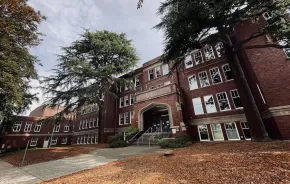
Photo:
iStock
Seattle Public Schools (SPS) is currently facing significant internal challenges and public pushback as it considers the closure of several elementary schools in response to declining enrollment and budget constraints. Optimistically, SPS is sharing information about the proposal under the umbrella of the initiative called Well-Resourced Schools, which launched last June.
“Like many districts,” Superintendent Brent Jones explained, “Seattle Public Schools is facing declining enrollment and budget challenges. As a result, many of our schools are struggling to provide the resources our students deserve.” According to the District, over 4,000 students have left SPS over the past five years.
Update as of Oct. 2: Five SPS schools to possibly close
In an email addressed to SPS families, staff and community on the evening of Oct. 1, Superintendent Jones shared a revised plan to address the district’s $100 million budget deficit for the 2025–26 school year. The new proposal includes potentially closing five schools.
According to the letter, the selection process for which schools will be identified for possible consolidation will be based on factors such as building condition, capacity and minimizing disruption. As per the Superintendent, “Under the revised proposal, K–8 and option schools – including those with specialized service models like Deaf and Hard of Hearing and Dual Language Immersion – are not under consideration for the upcoming school year.”
Recommendations will be shared with the school board by the end of October. Community members can share questions and feedback through the District’s online portal.
Why SPS is focusing on elementary schools
SPS is concentrating its school closure proposal on elementary and K–8 schools. Of the total 104 schools in the District, SPS operates 73 that specifically serve younger students. The targeted schools are facing challenges due to declining enrollment. Currently, 29 elementary schools serve fewer than 300 students.
By closing under-enrolled schools, SPS is arguing that resources can be more effectively consolidated so that schools can offer a more robust educational experience for students.
Budget crisis fuels closure proposal
According to Seattle Public Schools, the District is facing a significant budget shortfall of $94 million. The proposed closures could yield annual savings ranging from $26 million to $31.5 million.
Some community members advocating for alternative solutions are urging the District to explore legislative support for increased K–12 funding rather than resorting to closures that might not adequately address the District’s projected deficit.
The District claims that if it does not consolidate elementary schools, staffing throughout SPS will have to be reduced — resulting in layoffs. On the Well-Resourced Schools FAQ page, the District lists potential options to stretch funds that SPS could explore as an alternative to school closures. Examples of those options include:
- Class size increases across K–12 classrooms
- Reduce or eliminate preschool offerings
- Reduce or eliminate athletics
- Reduce school specialist staff (art, music, physical education)
- Reductions in security
- Reductions in grounds, custodial, maintenance staffing
Notably, many of these options touch on parents’ most significant concerns around safety and accessible extracurricular opportunities. These concerns are magnified for caregivers of Seattle students in lower-income communities where there are higher rates of violence and access is more limited to affordable out-of-school activities like sports and arts programs.
Community concerns focus on inequity
The potential options have sparked a wave of protests among parents, teachers and community members citing critical concerns about the impact on students, especially children in marginalized communities who have been historically furthest from educational justice. Many of the schools targeted for closure serve a high percentage of students of color, underscoring questions about equity and access to quality education.
According to the Seattle Times, during an anti-closure demonstration held ahead of the SPS board meeting on Sept. 18, approximately 300 protesters wore red and chanted “Save our schools!” outside SPS headquarters. Hand-painted protest signs included rally calls such as “Option C” and “Keeping Schools Open is the Only Option.”
Demonstrators’ criticism focused on fears that closing schools will disrupt established school communities and disproportionately affect students needing special education services. Many young students participated alongside the adults present.
Community engagement stalled
On Monday, Sept. 23, in a letter from Superintendent Jones, SPS announced all community meetings about the Well-Resourced Schools proposal were canceled.
“While our financial challenges are real and it’s our fiscal responsibility to resolve them, it is very clear we need more time to listen and earn your trust as we resolve our structural deficit and revisit our timeline,” Dr. Jones wrote.
In his earlier letter from Sept. 11, the Superintendent had outlined a series of upcoming opportunities for community members who are interested in learning more or weighing in on SPS’s Well-Resourced Schools proposal. Options ranged from an online information session in September, to in-person public meetings and hearings through November. The final school board vote on the initiative was planned for December before winter break.
Proposed initial plans
In a public letter to SPS families dated Sept. 11, Superintendent Jones announced two proposals that could lead to the shuttering of either 17 or 21 elementary and K–8 schools as part of the Well-Resourced Schools initiative:
- Option A: This plan would close 21 schools, including traditional elementary schools and K–8 schools like Salmon Bay K–8 and South Shore PreK–8. All K–8 options would be eliminated, requiring students in grades 6–8 to enroll in designated middle schools.
- Option B: This option would close 17 schools, including many of the same schools included in Option A. Some K–8 schools would be maintained.
Editor’s note: This article was originally published on Sept. 20, and was updated by the author on Wednesday, Oct. 2 and Tuesday, Sept. 24 to reflect SPS’s most recent announcements about the proposal. This page will be updated as new information is available.











